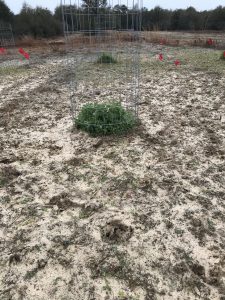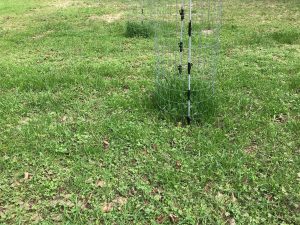I routinely receive calls about “failed food plots.” My normal response is to ask about soil testing first. If they performed a soil test and applied fertilizers according to the test, I move on to more questions about the planting methods. I ask what was planted, how was it planted, when was it planted. In some cases, we don’t find the problem even after all these questions. This leads me to my next question: Did you put exclusion cages on your plot?
In my experience, I have seen wildlife feed so heavily on the food plot that you think it has failed. This can happen when you have high populations or where non-target animals feed on the plot. In one case, I saw turkeys feeding on newly sprouted plants so heavily that we had “bald spots” in the plot. In another instance, I was called to check a chufa plot that wasn’t performing well. When I arrived at the plot, there were rabbits digging up the chufas and eating them before they sprouted. In the photo here, I am showing heavy deer feeding on a demonstration plot with exclusion cages. Without exclusion cages, I would have assumed a crop failure.
Exclusion cages are simple structures that allow you to see what is growing in the plot versus what the wildlife are eating. They are easy to create and put in place. I use field fence with small openings. I use a piece that is about 5-6 foot long by 3-4 foot high. I roll the fence and make it into a circle that is about 18 inches in diameter. Then, I secure the cage in the plot with landscape staples or rods/posts. I normally install these directly after planting and fertilizing the plot.
Exclusion cages are just another tool to use in evaluating food plot success. These simple tools allow us to see what is growing and compare that to what the wildlife are eating. This allows us to evaluate the food plot. I would also recommend using visual observation. Look for wildlife sign in the food plot. What tracks do you see? Do you see evidence of feeding on the forages? Game cameras are also helpful in determining what wildlife are feeding on the plot. Use your tools wisely to evaluate food plot success each season and adjust accordingly.
- Have a Safe and Legal Hunting Season - November 10, 2025
- Killer Turkey Food Plot - January 31, 2025
- Common Wildlife Food Plot Mistakes - November 8, 2024


